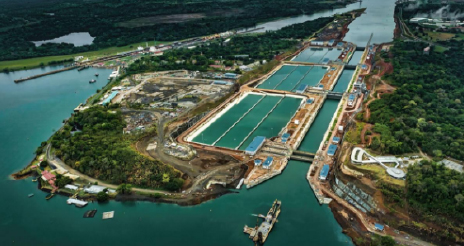- Our Mandate
- Mission and Objectives
- UNDRR in the UN
- Work Programme & Annual Reports
- Results Based System
- Work Partnerships
- Headquarters - Geneva
- SG-UN representatives for DRR
- Regional Office – The Americas and the Caribbean
- Head of the Regional Office – The Americas and the Caribbean
- What is Disaster Risk Reduction?
- What is the International Strategy?
- History of UNDRR
The Panama Canal, example of sustainability and water use efficiency

Panama Canal expansion. Photo Cred: Authority of the Panama Canal (ACP).
By: UNDRR – The Américas
PANAMA CITY, Panama, June 23rd, 2016— In the midst of one of the worst droughts in decades, the expansion of the Panama Canal starts its operation as an example of sustainability and efficiency in water use. The new labor is imposed as a model of adaptation to climate change and disaster risk reduction, thanks to their water system that will allow an efficient response to climatic and geological risks that have affected the Canal in previous years.
The Panama Canal depends on water reserves and Madden lakes Gatun, whose preservation is monitored by the Panama Canal Authority (ACP). It is expected that the new system tubs and locks itself for enlargement, let strengthen the preservation of water resources and ensure the smooth operation of the Canal against future periods of drought.
According to Carlos Vargas, executive vice president of Environment, Water and Energy of the ACP; the savings would be based on the priority system design tubs and new locks that compared to the traditional system of locks, allow savings of 60%. The new system will increase the traffic capacity of ships in type and number, and reduce overall water use by 7%.
"For Panama it´s extremely critical to have a sustainable management of water resources throughout the basin of the Canal, particularly in the section that maintains appropriate water levels in the Gatun Lake," said Ricardo Mena, head of the Regional Office for the Americas United Nations Office for Disaster Risk Reduction (UNDRR).
Droughts are a frequent topic in Central America, mainly in the Dry Corridor, which strongly affects the economies and people of the region. According to the Intergovernmental Panel on Climate Change (IPCC), the frequency of extreme weather events will increase. Reason why the next 20 years are expected to experience between three and five droughts as well as an increase in the number of tropical storms.The danger of more frequent and stronger future droughts and floods, call for a change on the part of states and citizens to protect and ensure the proper management of water resources and the stability of its infrastructure to ensure their protection and reduce disaster risk. Ricardo Mena, it is necessary to create "a culture of saving water, you have to emphasize the fact that, although there is enough water, saving and prevention is absolutely vital for resilience and the country's development"
It is worth noting that Panama was one of the countries affected by El Niño. As a result, this year due to rainfall deficit the movement of large ships in the Canal was limited before the opening of the extension. Additionally in 2010, flooding affected large infrastructure forcing its temporary closure. According to Antonio Michel, executive director of Protection and Emergency Response of the ACP; excess water -consequence of tropical storms and heavy rains - is one of the main risks of the Canal.
The new expansion of the Canal, whose construction took nine years and cost some 5,000 million dollars, will begin operating on Sunday July 26th. The ACP, which currently has a number of response plans and training to respond to damage to Canal and the basin, is also working on a new contingency plan, which would allow the preparation and efficient response to future events that could affect the Canal.
Related Links:
IPCC
Follow the UNDRR news online:
 Now we have twitter account @UNDRR Américas y el Caribe
Now we have twitter account @UNDRR Américas y el Caribe
JOIN US!
Tweets por el @UNDRR Américas y el Caribe
